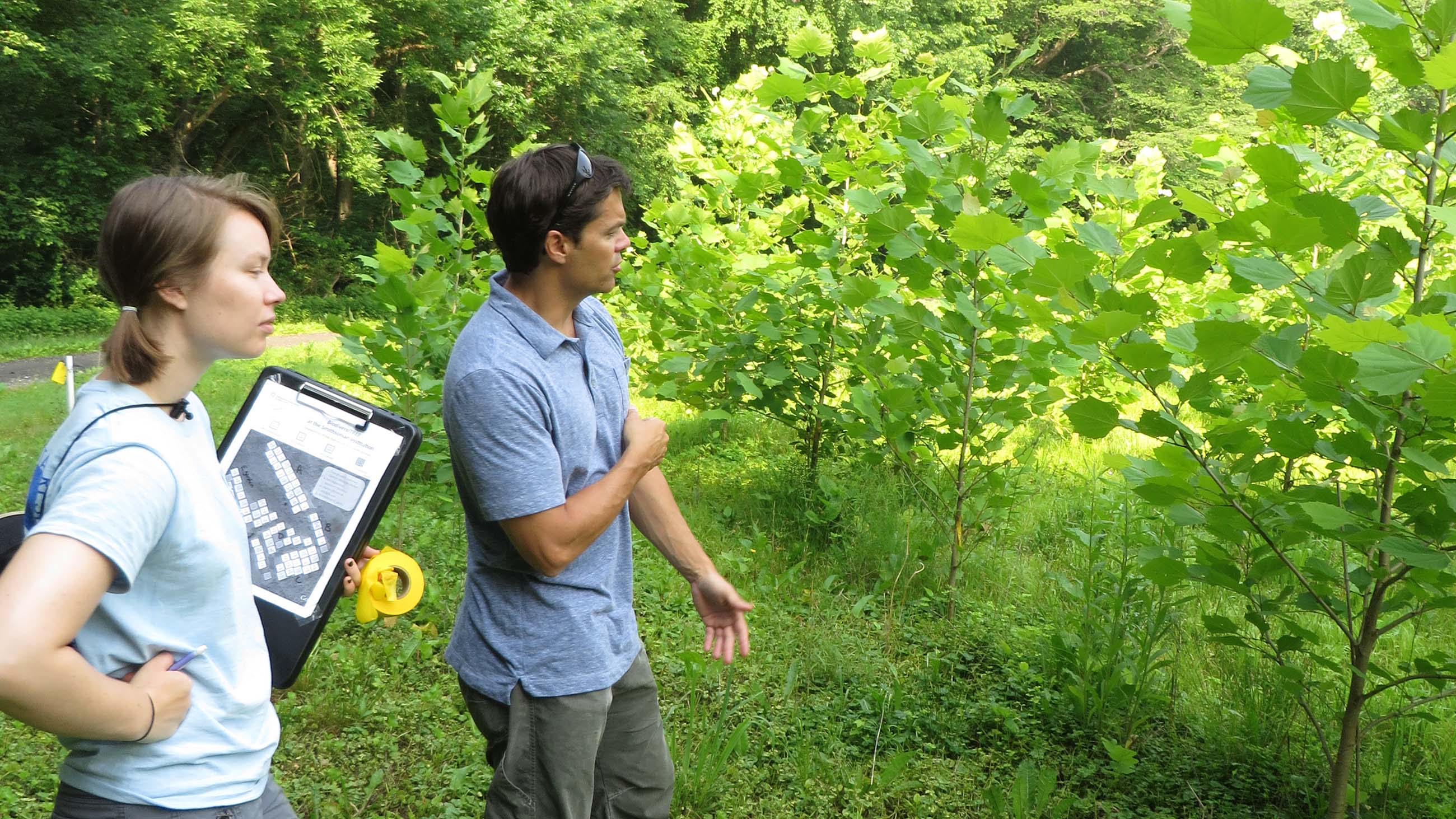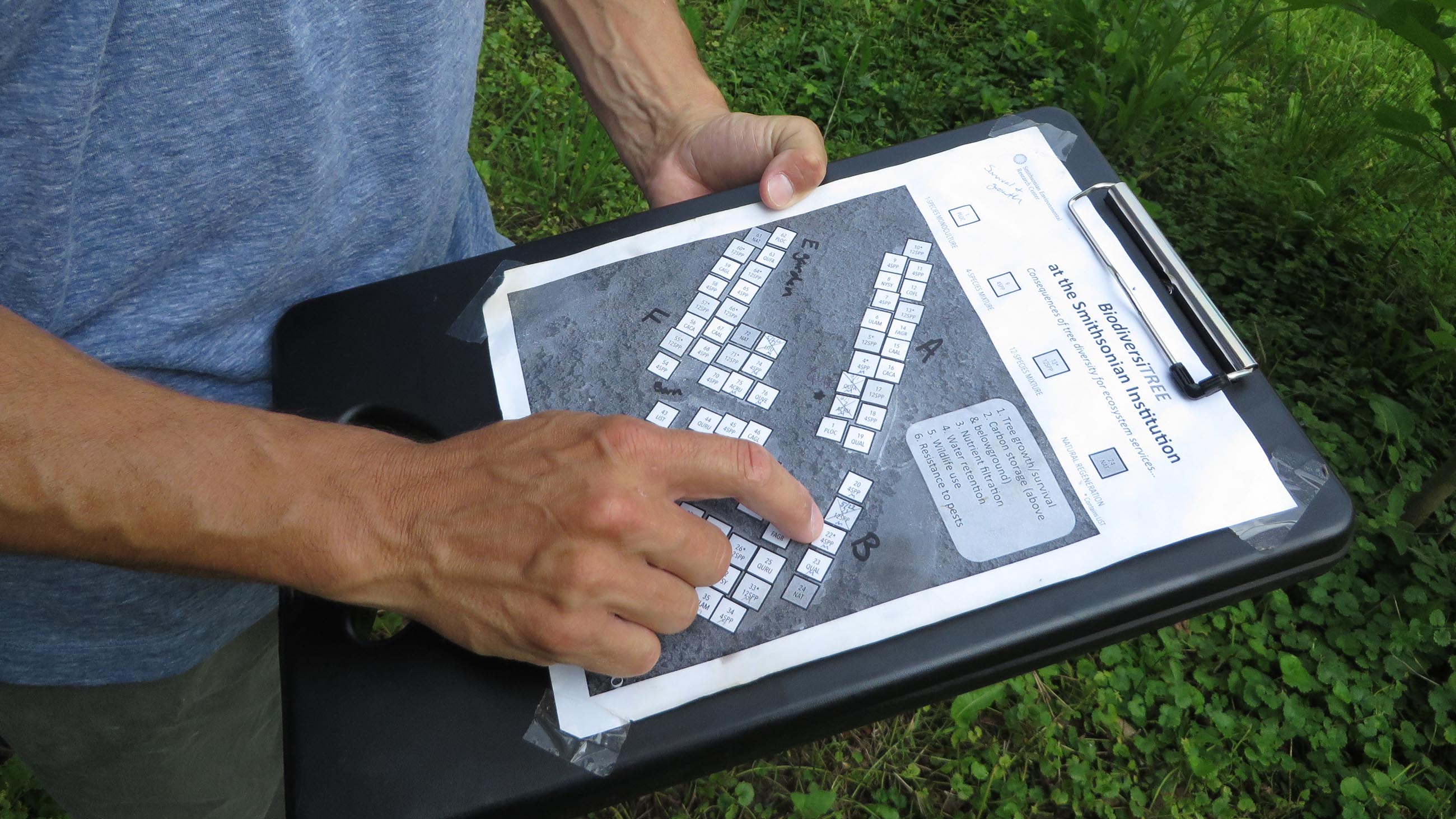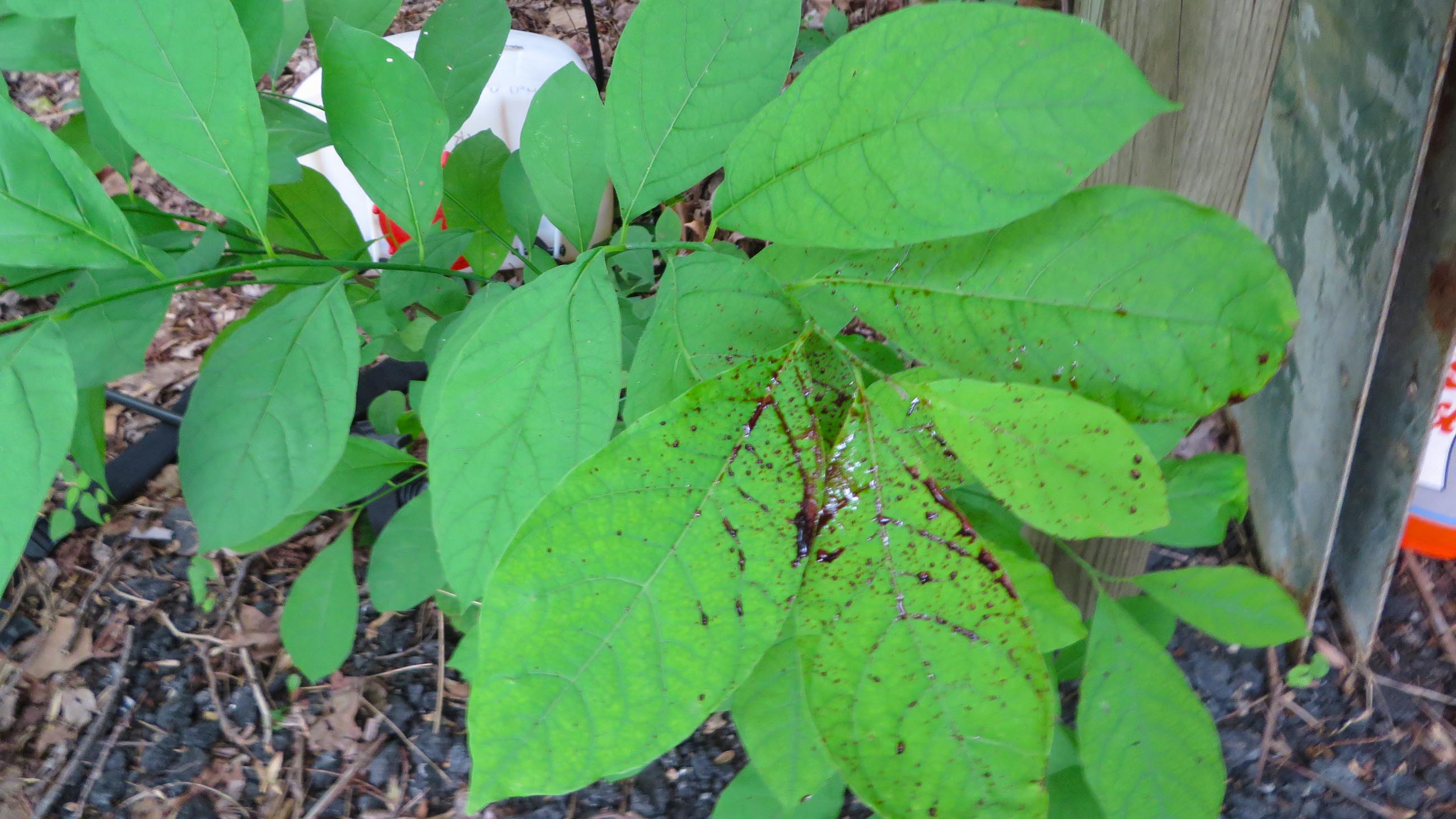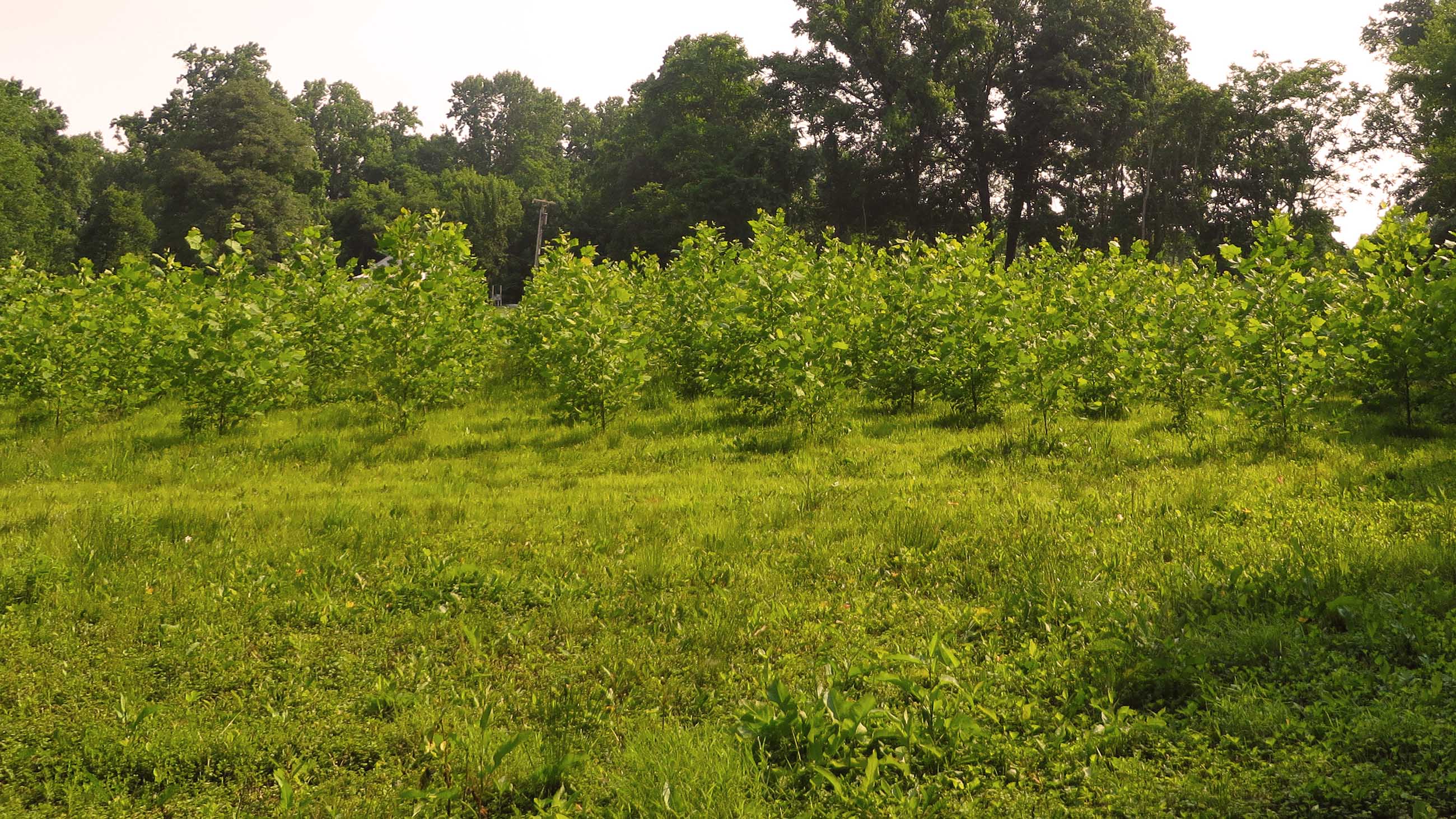The Hundred-Year Experiment
Near the western shore of the Chesapeake Bay, a former cornfield lies surrounded by lush deciduous forest. Rows and rows of saplings grow there, as in a nursery. Spiny weeds enclose the shorter trees like small cages, protecting them from hungry deer. A patch of sycamores, a little taller than a grown man, towers over the knee-high oak saplings. Crickets chirp away incessantly. At 9:30 on a late spring morning, it is already sweltering hot.
But the heat and the blazing sun do not deter the two scientists who have come to check on the baby trees. Jamie Smith, in her twenties, with light brown hair pulled into short pigtails, walks between them and ties yellow and orange plastic ribbons onto bamboo stakes, one for each tree. Yellow means alive, orange means dead. Smith is performing a survival census as part of a hundred-year experiment.
The 23-acre experimental area is divided into 75 square plots, each measuring 115 feet. Most plots now hold about 255 trees. “If you walk to each and every tree just to see if it is alive, it is 27 miles,” says Smith’s boss, John Parker, the principal investigator of the Terrestrial Ecology Lab at the Smithsonian Environmental Research Center (SERC) in Edgewater, Maryland. “So, [it’s] a marathon just to look at every tree.”
Smith, the lab’s head technician and the one actually making the rounds, bursts into laughter.
Three years ago, Parker embarked on an extraordinary experiment, one that will not be completed in his lifetime. It will take a hundred years because that is how long it takes for a forest to become full-grown.
One goal is to find out how the diversity of tree species in the experimental plots will affect the cleanliness of the water passing through the soil and eventually reaching the Chesapeake Bay. Another is to understand which type of forest — low-diversity or high-diversity — is more resilient in the face of diseases and pest attacks. For that reason, Parker named the experiment BiodiversiTree. Different plots have different numbers of tree species: one, four, or 12. He keeps the diversity constant by regularly mowing the plots for weeds and hacking undesired self-seeded saplings with a machete. As a control, five plots are left unplanted to see what happens naturally.

At 45 years old, Parker, tanned and muscular, wears clothing appropriate for the job — brown-and-green hiking shoes and a heather-gray polo shirt that falls loosely over long gray cotton pants. The role of outdoor scientist suits him. Growing up in the Chesapeake Beach section of Virginia Beach (locals call it Chic’s Beach), he spent a lot of time in the water and loved to watch nature documentaries. Scientists like Jacques Cousteau had such cool jobs that Parker says he doubted they were actual professions. Now he’s working in one of them. “So that worked out in a funny way,” he says.
In college, Parker tried economics and pre-med before committing himself to environmental science. He worked as a geologist for two years but found the work unexciting. He decided to continue his studies — first with a master’s in marine science at the College of William and Mary, then a doctorate in biology at the Georgia Institute of Technology. Parker’s interests evolved from marine to aquatic to terrestrial, curiously mimicking the way plants evolved: starting in the ocean as algae, creeping into freshwater streams, and finally invading dry land.
It was an unpleasant surprise during his postdoctoral studies at Cornell that helped steer Parker toward forest diversity. In the middle of an experiment on how herbivores affect the genetic diversity of the common evening primrose, a sudden attack by meadow voles destroyed 70 percent of his nearly 4,000 plants. “You would think that would be incredibly discouraging, but John, being the determined individual he is, turned it into an excellent paper,” says Susan Cook-Patton, Parker’s research associate at SERC, who met him at Cornell. It turned out that the plots with more genetically diverse plants (some short, some tall; some fast growers, others slow growers; and so on) had much higher survival rates than the plots with only a single trait.
At the time, scientists in Minnesota were experimenting with the biodiversity of grasses — a concept similar to BiodiversiTree, but smaller in scale and time. Parker knew that forests had higher biodiversity than grasses, so he decided to do a large-scale experiment with trees. Besides a Smithsonian grant, SERC came up with another source of funding for the project: a Maryland program that requires developers to contribute to a “forest mitigation” fund when they clear land within 1,000 feet of the Chesapeake Bay. Forests are valued for their ability to suck up fertilizer runoff and filter the water before it enters the bay. They also act as a sponge by retaining rainwater and preventing flash floods. SERC could receive money from the developers by reforesting farmland near the bay.
One day, Parker’s boss, Anson Hines, asked him, “What if we convert all those [SERC] fields to forest, what would you do with it?” With Cook-Patton, Parker eagerly began planning the BiodiversiTree experiment and proposed it to Hines. “Oh, he doubted me,” Parker says now. “He didn’t think we would pull it off and get it all in the ground [on] such a large scale.”
Hines says he was excited about the idea, but was “concerned about the practical aspect of executing it.” He wanted Parker and Cook-Patton to do smaller sections at first, and then expand, but Parker convinced him that the experiment would be most effective if all the plots were planted at the same time.


The project depends on a team of scientists, interns, and volunteers. Cook-Patton, who is also a AAAS Science and Technology Policy Fellow at the U.S. Forest Service, says that Parker’s way of working reminds her of a saying of Mark Twain’s: “Eat a live frog first thing in the morning and nothing worse will happen to you the rest of the day” — in other words, if you start your day with the most difficult task, everything else will be easier. Some people dive into hard work and others put it off, she says. “John is the first kind. If there was a terrible job that needs to be done, he would do it.”
Indeed, Parker personally drilled many of the holes for the 24,000 young trees and planted a large number on his own. Cook-Patton was responsible for much of the experimental design and planting, which took place in miserable weather in the cold, wet spring of 2013. Smithsonian scientists and more than a hundred volunteers worked in a race against time for seven weeks. If the year-old saplings leafed out before their roots were in soil, they would die of dehydration. Even Parker’s two kids, then seven and 10 years old, helped, and about 150 citizen scientists are now involved in the project.
Today, 78 percent of the saplings are still alive, all four years old and growing in plots with different levels of biodiversity. Monoculture plots have only one species, such as pignut or sycamore. Polyculture plots have either four or 12 species, a mixture of different types of local trees like red maple, oaks, beech, tulip, sweetgum, and ash. The unplanted plots are “a tangled mass of shrubs,” says Parker.
Now the scientists check the trees regularly and help them grow by mowing the weeds between the rows and spraying them with a deer repellent reconstituted from the powdered blood of slaughtered pigs. (The odor is supposed to fool deer into thinking there is a carnivore nearby.) “It smells like a slaughterhouse,” Parker says with a grimace. Once, an intern spilled a whole bucket of blood over himself and went home to clean up. Parker thought he would never return, but the next day he was back fresh and clean, unshaken by the experience.
Besides the century-long experiment, Parker works on several other forest ecology projects, including one that takes him to Florida in winter to study the ranges of mangrove forests, which are expanding north with rising temperatures and may reach mid-Georgia within sixty years.
Parker knows he will not live to see the end of his BiodiversiTree experiment. A succession of scientists will pass the torch into the 22nd century. But by the time he retires, he says he hopes at least to get some answers on the best ways to restore vanished forests.
Some scientists would rather leave the solutions to nature. “If you plant, it costs a lot of money,” says Mark Ashton, a professor of silviculture and forest ecology at Yale University. “You could probably let nature do the reforestation at zero cost.” Both single- and multiple-species forests occur naturally, depending on regional climate, soil, and nearby forests, he continued: “Nature is not all about mixtures.”
But Kris Verheyen, the coordinator of TreeDivNet, a global network in which BiodiversiTree participates, thinks the results of the 100-year experiment could have many applications. “And the applications change as the experiments grow old,” he says.
The very early stages could help scientists and forest managers learn how to establish monoculture and polyculture plantations, and in which type different species are more likely to survive. Later, they will glean information on the trees’ susceptibility to pests, diseases, and climate stress such as drought — findings that may point the way to better survival strategies.
For forest managers, the results may also indicate which types of forests produce high-quality timber. Forests planted by humans are still mostly monocultures, “but in the face of global change this type of plantation may be at risk,” Verheyen says. “If you want to come to a more resilient forest in the future, these polycultures probably have big value.”
This article has been updated to add the word “polyculture” to the penultimate paragraph, which was dropped in error during editing.
Margarita Yatsevich is a Washington, D.C.-based science writer. She is currently completing a master’s degree in Science Writing at Johns Hopkins University.










